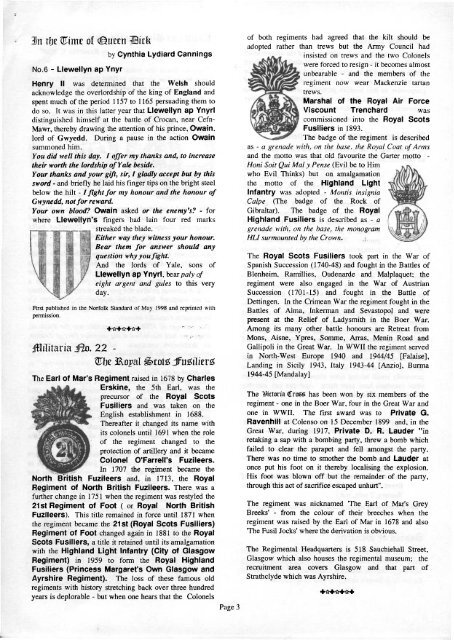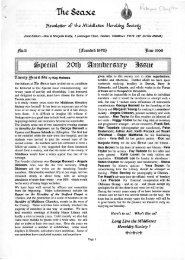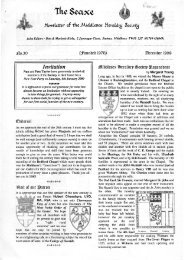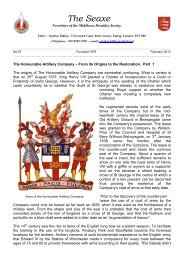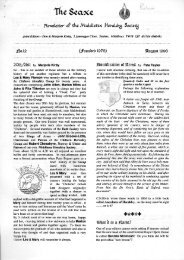The Seaxe - Middlesex Heraldry Society
The Seaxe - Middlesex Heraldry Society
The Seaxe - Middlesex Heraldry Society
You also want an ePaper? Increase the reach of your titles
YUMPU automatically turns print PDFs into web optimized ePapers that Google loves.
In the Time of Queen Dick<br />
No.6 - Llewellyn ap Ynyr<br />
by Cynthia Lydiard Cannings<br />
Henry II was determined that the Welsh should<br />
acknowledge the overlordship of the king of England and<br />
spent much of the period 1157 to 1165 persuading them to<br />
do so. It was in this latter year that Llewellyn ap Ynyrl<br />
distinguished himself at the battle of Crocan, near Cefn-<br />
Mawr, thereby drawing the attention of his prince, Owain,<br />
lord of Gwynedd. During a pause in the action Owain<br />
summoned him.<br />
You did well this day. I offer my thanks and, to increase<br />
their worth the lordship of Yale beside.<br />
Your thanks and your gift, sir, I gladly accept but by this<br />
sword - and briefly he laid his finger tips on the bright steel<br />
below the hilt - I fight for my honour and the honour of<br />
Gwynedd, not for reward.<br />
Your own blood? Owain asked or the enemy's? - for<br />
where Llewellyn's fingers had lain four red marks<br />
streaked the blade.<br />
Either way they witness your honour.<br />
Bear them for answer should any<br />
question why you fight.<br />
And the lords of Yale, sons of<br />
Llewellyn ap Ynyrl, bear paly of<br />
eight argent and gules to this very<br />
day.<br />
First published in the Norfolk Standard of May 1998 and reprinted with<br />
permission.<br />
Militaria No. 22 -<br />
<strong>The</strong> Royal Scots Fusiliers<br />
<strong>The</strong> Earl of Mar's Regiment raised in 1678 by Charles<br />
Erskine, the 5th Earl, was the<br />
precursor of the Royal Scots<br />
Fusiliers and was taken on the<br />
English establishment in 1688.<br />
<strong>The</strong>reafter it changed its name with<br />
its colonels until 1691 when the role<br />
of the regiment changed to the<br />
protection of artillery and it became<br />
Colonel O'Farrell's Fuzileers.<br />
In 1707 the regiment became the<br />
North British Fuzileers and, in 1713, the Royal<br />
Regiment of North British Fuzileers. <strong>The</strong>re was a<br />
further change in 1751 when the regiment was restyled the<br />
21st Regiment of Foot ( or Royal North British<br />
Fuzileers). This title remained in force until 1871 when<br />
the regiment became the 21st (Royal Scots Fusiliers)<br />
Regiment Of Foot changed again in 1881 to the Royal<br />
Scots Fusiliers, a title it retained until its amalgamation<br />
with the Highland Light Infantry (City of Glasgow<br />
Regiment) in 1959 to form the Royal Highland<br />
Fusiliers (Princess Margaret's Own Glasgow and<br />
Ayrshire Regiment). <strong>The</strong> loss of these famous old<br />
regiments with history stretching back over three hundred<br />
years is deplorable - but when one hears that the Colonels<br />
Page 3<br />
of both regiments had agreed that the kilt should be<br />
adopted rather than trews but the Army Council had<br />
insisted on trews and the two Colonels<br />
were forced to resign - it becomes almost<br />
unbearable - and the members of the<br />
regiment now wear Mackenzie tartan<br />
trews.<br />
Marshal of the Royal Air Force<br />
Viscount Trenchard was<br />
commissioned into the Royal Scots<br />
Fusiliers in 1893.<br />
<strong>The</strong> badge of the regiment is described<br />
as - a grenade with, on the base, the Royal Coat of Arms<br />
and the motto was that old favourite the Garter motto -<br />
Honi Soit Qui Mal y Pense (Evil be to Him<br />
who Evil Thinks) but on amalgamation<br />
the motto of the Highland Light<br />
Infantry was adopted - Montis insignia<br />
Calpe (<strong>The</strong> badge of the Rock of<br />
Gibraltar). <strong>The</strong> badge of the Royal<br />
Highland Fusiliers is described as - a<br />
grenade with, on the base, the monogram<br />
HLI surmounted by the Crown.<br />
<strong>The</strong> Royal Scots Fusiliers took part in the War of<br />
Spanish Succession (1740-48) and fought in the Battles of<br />
Blenheim, Ramillies, Oudenarde and Malplaquet; the<br />
regiment were also engaged in the War of Austrian<br />
Succession (1701-15) and fought in the Battle of<br />
Dettingen. In the Crimean War the regiment fought in the<br />
Battles of Alma, Inkerman and Sevastopol and were<br />
present at the Relief of Ladysmith in the Boer War.<br />
Among its many other battle honours are Retreat from<br />
Mons, Aisne, Ypres, Somme, Arras, Menin Road and<br />
Gallipoli in the Great War. In WWII the regiment served<br />
in North-West Europe 1940 and 1944/45 [Falaise],<br />
Landing in Sicily 1943, Italy 1943-44 [Anzio], Burma<br />
1944-45 [Mandalay]<br />
<strong>The</strong> Victoria Cross has been won by six members of the<br />
regiment - one in the Boer War, four in the Great War and<br />
one in WWII. <strong>The</strong> first award was to Private G.<br />
Ravenhill at Colenso on 15 December 1899 and, in the<br />
Great War, during 1917, Private D. R. Lauder "in<br />
retaking a sap with a bombing party, threw a bomb which<br />
failed to clear the parapet and fell amongst the party.<br />
<strong>The</strong>re was no time to smother the bomb and Lauder at<br />
once put his foot on it thereby localising the explosion.<br />
His foot was blown off but the remainder of the party,<br />
through this act of sacrifice escaped unhurt".<br />
<strong>The</strong> regiment was nicknamed '<strong>The</strong> Earl of Mar's Grey<br />
Breeks' - from the colour of their breeches when the<br />
regiment was raised by the Earl of Mar in 1678 and also<br />
'<strong>The</strong> Fusil Jocks' where the derivation is obvious.<br />
<strong>The</strong> Regimental Headquarters is 518 Sauchiehall Street,<br />
Glasgow which also houses the regimental museum; the<br />
recruitment area covers Glasgow and that part of<br />
Strathclyde which was Ayrshire.


